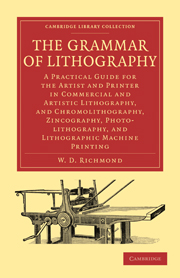 The Grammar of Lithography
The Grammar of Lithography Summary
There formerly existed a deep-seated and it must be admitted an unreasoning prejudice, against technical hand-books treating practically of any trade or profession. It was sedulously instilled into the minds of the young especially, that an acquaintance with the processes of the different industrial occupations could be acquired only by observing and imitating the methods of adepts. This idea was fostered by persons possessed largely with a selfish motive: they had gained their own knowledge of their art in the tedious and irksome manner which, in their case, was the only possible one, and were determined, as far as lay in their power, that such knowledge should be obtained by their successors in the same unintelligent way.
The rise of trade journalism, which is coincident with the establishment of The Builder—a periodical that has, in a variety of ways, been of signal service to the industrial community—and the gradually increasing influence and importance attained by the newspapers which each trade and interest soon brought into existence, showed the fallacy of the old prejudice; and it proved what was even of more consequence, the great and substantial use which might be made of the Press in imparting technical instruction, partly supplementary to and partly independent of workshop and laboratory practice. A large class of persons became accustomed to find their practical knowledge, even in their own peculiar métier, increased and enlarged by the perusal of articles in serials of this character; and it was only a natural development of things when the articles grew into treatises, when isolated facts, hints, recipes, and instruction were welded together into connected grammars, guides, and hand-books of the different departments of craftsmanship.
- Type
- Chapter
- Information
- The Grammar of LithographyA Practical Guide for the Artist and Printer in Commercial and Artistic Lithography, and Chromolithography, Zincography, Photo-lithography, and Lithographic Machine Printing, pp. ix - xivPublisher: Cambridge University PressPrint publication year: 2010First published in: 1878


